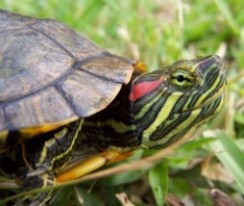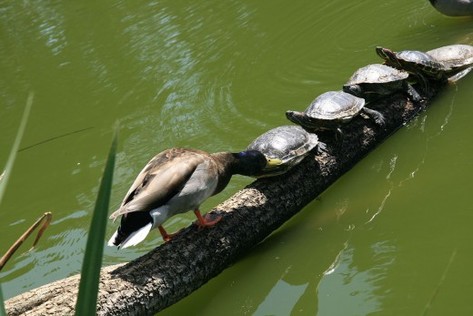Red Eared SliderTrachemys scripta elegans |

Custom Search
|
|
The red-eared slider (Trachemys scripta elegans) is found in Central and southeastern United States, on the Mississippi River, eastern Kentucky, Alabama and Florida, and northern Gulf of Mexico.
Turtles can be considered authentic survivors of prehistory, as if we return 200 million years in time, we would find very little difference between the prehistoric turtles and the turtles today. The dinosaurs became extinct but not turtles, good for them. The red-eared slider turtle lives in ponds, lakes, streams and rivers of weak current, preferring areas of abundant vegetation. This species has been introduced as an invasive species in many places around the world, including Africa and South Asia. Due to its great capacity to reproduce and adapt to new environments, in some countries like Australia, Canada, France, Sweden and South Africa, importation is prohibited, because the animals end up escaping from captivity or being released by owners that no longer want them, competing with animals for environments similar to theirs and causing imbalances and damage, especially to other turtle species.
The red-eared slider is the most popular pet turtle in the world, its sale has already been popularized worldwide in the U.S. alone are exported more than 7 million animals per year.
In adults, the carapace (upper shell) measures from 25 to 32 cm long (10 to 13 inches), it is oval shaped, dark green with yellow spots and stripes, the plastron (bottom shell) is yellow and has green spots that form a pattern variable an unique among individuals. There are records of males that were progressively darkening with age and eventually become almost black. In the neck, they typically have an reddish, longitudinal bar, just behind the eyes, hence its name red eared slider. They have webbing between the toes (interdigital membranes), which they use to facilitate the movement in the water. There is sexual dimorphism in the species, males are smaller, have thicker and longer tails and the nails of the front legs are much longer than in females. They are diurnal animals. They prefer waters with muddy bottoms, abundant vegetation and floating logs, in which, they gather to take long sunbaths. However, they slide to the water at the slightest sign of danger, a fact that gave them the "slider" part of their common name. From October to April they hibernate in the the bottom of lakes or rivers where they live. Red-eared slider diet Juvenile turtles feed on snails, tadpoles, insects and crustaceans, and have more carnivore habits than adult turtles. Adults are mainly vegetarian, eating water lilies, arrowhead, hyacinths and duckweed. The red-eared slider has an important role in their environment, helping to control populations of the animals that they feed on and the in aquatic vegetation as they graze. They don't produce saliva, and need to be in water to swallow the food. Red-eared slider reproduction It's an oviparous species. The mating season runs from March to June. The mating ritual is very characteristic of this species, the male positions himself in front of the female playing with the front nails in her neck, if the female is receptive, they go to the bottom where mating takes place. From June to July, the female can generate from one to three clutches, from 4 to 23 eggs each, in a hole dug in the ground. The young are born after about two months of incubation. The sex of individuals is dependent on the incubation temperature of eggs. The newly hatched little turtles measure about 2 to 3.5 cm, they are more rounded and have brighter colors than adults. But the hatchlings grow rapidly, reaching almost 5 centimeters (2 inches) in a year, but as they become adults their growth rate slows down. Young turtles represent an important food source for large aquatic predators. The male red-eared slider turtle becomes sexually mature when they are aged between 2 and 5 years. At this time, they will have more than 10 cm long shells (4 inches). The females take longer to reach sexual maturity and it occurs when they have from 5 to 7 years of age and their carapace measures approximately 15 to 19 centimeters (6 to 7.5 inches). The adult animal in captivity reaches about 30 cm and in the wild about 40 cms. They can live approximately 40 years in the wild and up to 100 in captivity. There are also some color variations in the species Trachemys scripta elegans, varying from cases of albinism, leucistic and pastel colors. Red-eared slider Conservation status and main threats This species has the status of low risk / near threatened (by the International Union for Conservation of Nature). The indigenous populations have declined with catches for human consumption and the illegal trade of pet animals. However, this species is created intensively on farms in the U.S. to be marketed worldwide as a pet and is undoubtedly one of the most abundant species of reptiles, worldwide. The introduction of this species in locations outside their original distribution has, on the other hand, caused serious ecological problems in some areas due to competition of this very adaptable and generalist turtle with other native species.
|
Scientific classification
Kingdom: Animalia Phylum: Chordata Class: Reptilia Subclass: Anapsida Order: Testudines Family: Emydidae Genus: Trachemys Species: T. scripta Subspecies: T. s. elegans |



